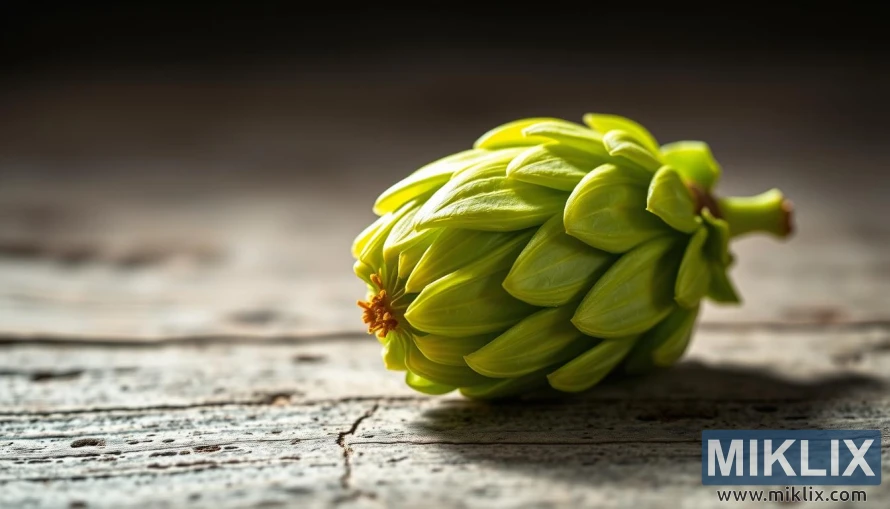Image: Amarillo Hop Cone Detail
Published: July 21, 2025 at 2:58:46 PM UTC
Last updated: September 26, 2025 at 6:06:45 PM UTC
Macro shot of an Amarillo hop cone with yellow lupulin glands, showing its resin-filled interior, textures, and structure under crisp studio lighting.
Set against a rustic wooden surface, the Amarillo hop cone in this image takes on a role that is both scientific specimen and natural artwork. Its vibrant green form, captured in extraordinary detail, draws the eye immediately to its layered bracts, each petal-like structure curling slightly outward as though unveiling the complexity within. Light falls with deliberate precision across the hop, illuminating its contours and casting sharp yet elegant shadows on the weathered wood beneath it. This careful interplay of brightness and shadow highlights the structural intricacies of the cone: the delicate papery outer leaves, the faint veins running along each bract, and the tight spiral pattern that protects the precious lupulin glands nestled inside. The contrast between the hop’s living vibrancy and the subdued, neutral tones of the background emphasizes its importance, isolating it as an object of study and admiration alike.
Upon closer inspection, the textures become even more fascinating. The bracts, though thin and fragile to the touch, are arranged with remarkable resilience around the central stem. Within their folds lies the true treasure: the yellow lupulin glands, resinous and aromatic, responsible for imparting the signature character Amarillo hops are prized for. These glands, though not fully visible, are suggested by the gentle bulge of the bracts and the faint golden undertones that glimmer in the play of light. For brewers, this resin is the essence of possibility—bursting with floral notes, citrus brightness, and earthy undertones that can transform a brew into something memorable. For the observer, it is the hidden heart of the cone, a reminder that what appears as a simple green form is, in truth, a highly sophisticated natural mechanism designed both for reproduction and for flavor.
The wooden surface beneath the hop adds a grounding element to the composition. Its cracks, grooves, and weathered appearance speak of time and use, a fitting counterpart to the freshness of the cone resting upon it. This juxtaposition between the enduring and the ephemeral captures something fundamental about brewing itself: the blending of tradition with the fleeting freshness of ingredients. The wood, neutral in its tone, does not compete with the hop but instead amplifies its vivid coloration. Every line of grain and every softened shadow serves to frame the cone as the undisputed focus, while the darker background recedes into quiet nothingness, further sharpening the sense of spotlight on this single specimen.
Viewed through the lens of artistry, the hop becomes a subject of contemplation, its geometry almost architectural in nature. Each overlapping bract forms a tessellation of green, reminiscent of natural design principles found in pinecones, artichokes, and other botanical structures. The symmetry is not perfect but organic, reminding us of the variability that makes each hop cone unique. From a scientific perspective, this same close-up examination offers the chance to marvel at the evolutionary efficiency of the structure: bracts protecting delicate lupulin from sun, air, and damage until the moment of brewing unlocks their potential. The image, therefore, exists at the intersection of art and science, inviting both aesthetic admiration and technical appreciation.
There is also a meditative quality in the simplicity of the composition. With no distractions, the viewer is left alone with the hop, invited to consider not just its visual presence but the story it tells of cultivation, harvest, and eventual transformation. It symbolizes the start of a journey that leads from field to fermenter, from plant to pint. In its quiet stillness, it holds the promise of vibrant aromas, bitter balance, and the joy of shared experiences over a glass of beer. The dramatic lighting, the careful detail, and the sense of reverence all combine to elevate this single Amarillo hop cone into more than just an ingredient—it becomes a symbol of craft, patience, and the marriage of natural growth with human ingenuity.
The image is related to: Hops in Beer Brewing: Amarillo

